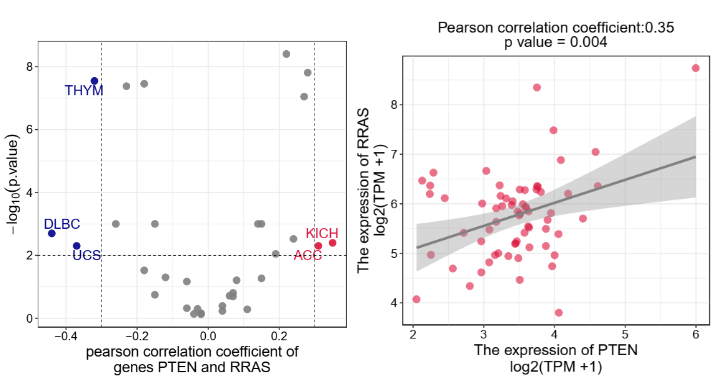生物信息数据分析教程视频——12-基因之间的相关性分析及可视化
生物信息数据分析教程视频——12-基因之间的相关性分析及可视化

DoubleHelix
发布于 2022-12-15 15:56:30
发布于 2022-12-15 15:56:30
文章被收录于专栏:生物信息云


视频地址:http://mpvideo.qpic.cn/0bc3niaasaaatialkbbtenrva2wdbfvaacia.f10002.mp4?
参考:
代码:
# https://mp.weixin.qq.com/s/X2kybql--KPgjUumWX4z9Q
# setwd("H:/MedBioInfoCloud/analysis/TCGA/new/conventionalAnalysis")
options(stringsAsFactors = F)
library(TCGAbiolinks)
library(WGCNA)
library(ggplot2)
library(ggpubr)
library(ggrepel)
library(corrplot)
library(pheatmap)
FilePath <- dir("H:/MedBioInfoCloud/analysis/TCGA/new/processedTCGAdata/TCGA-STAR_Exp/",
"STARdata.Rdata$",full.names = T)
geneset1 <- c("EGFR","PTEN","ATF1","ATF3","ADORA1")
geneset2 <- c("MVP","MGLL","TNS3","ANXA6","EHD2","TGM2","DPYSL2","TWF2","EHD1","RRBP1","RRAS")
opt <- "output/003-CorrelationsBetween_mRNAs/"
record_files <- dir(opt,"RecordInformation.txt$",full.names = T)
ifelse(length(record_files)>0,file.remove(record_files),
"There is no record file that can be removed")
source("H:/MedBioInfoCloud/analysis/TCGA/new/00-fun/filterGeneTypeExpr.R")
source("H:/MedBioInfoCloud/analysis/TCGA/new/00-fun/del_dup_sample.R")
###TCGA数据库中33中癌症类型
project <- getGDCprojects()$project_id
project <- project[grep("TCGA-",project)]
# proj = "TCGA-LUAD"
pandata <- data.frame()
for(proj in project){
message("===============================")
message(proj)
load(FilePath[grep(proj,FilePath)])#STARdata
tpm <- STARdata[["tpm"]]
tpm <- filterGeneTypeExpr(expr = tpm,
fil_col = "gene_type",
filter = FALSE)
##过滤不表达的基因
tpm <- tpm[apply(tpm,1,var) !=0,]
if(length(intersect(rownames(tpm),geneset1))> 0& length(intersect(rownames(tpm),geneset2))> 0 ){
##正常组织样本ID
SamN <- TCGAquery_SampleTypes(barcode = colnames(tpm),
typesample = c("NT","NB","NBC","NEBV","NBM"))
##肿瘤组织样本ID
SamT <- setdiff(colnames(tpm),SamN)
###去除重复样本
tur_exp <- del_dup_sample(tpm[,SamT],col_rename = T)
###long2转换
tur_exp <- log2(tur_exp + 1)
gs1 <- intersect(rownames(tpm),geneset1)
gs2 <- intersect(rownames(tpm),geneset2)
g1exp <- data.frame(t(tur_exp[gs1,]))
g2exp <- data.frame(t(tur_exp[gs2,]))
# method = "pearson"
for(method in c("pearson","spearman")){
cor_coef <- cor(g1exp,g2exp,method = method )
cor_p <- corPvalueStudent(cor_coef,nrow(g1exp))
col2 <- colorRampPalette(c("#3300CC","#3399FF","white","#FF3333","#CC0000"),alpha = TRUE)
# 相关性热图,基因数量太少,不绘制
if(min(length(gs1),length(gs2)) >= 3){
fp_corrplot <- paste0(opt,proj,"/corrplot/")
ifelse(dir.exists(fp_corrplot),"The folder already exists.",dir.create(fp_corrplot,recursive = T))
display_numbers = matrix(ifelse(cor_p > 0.01 | is.na(cor_p), "×", ""),
nrow(cor_p))
pdf(paste0(fp_corrplot,method,"-corrplot.pdf"),
width = ifelse(length(gs1)>=4,length(gs1)*0.9,3 ),
height = ifelse(length(gs2)>=4,length(gs1)*0.9,3 ))
corrplot(cor_coef, col = col2(100),method = 'square',cl.length=5,
tl.col="black",tl.cex = 1,cl.pos = "r",cl.ratio = 0.2,
cl.align.text = "l",
p.mat = cor_p, sig.level = c(.001, .01, .05),outline="white",
insig = "label_sig",pch.cex = 1.2, pch.col = "black")%>% print()
pheatmap(cor_coef,
#annotation_col =annotation_col,
# annotation_row = annotation_row,
color = col2(50),
cluster_cols =F,
fontsize=6,
cluster_rows = F,
fontsize_row=6,
cellwidth =10,
cellheight =10,
fontsize_number = 16,
display_numbers= display_numbers,
#scale="row",
show_colnames=T,
fontsize_col=8,
main = paste0(method," correlation")) %>% print()
dev.off()
}
###
# g1 = gs1[1]
# g2 = gs2[1]
fp_point <- paste0(opt,proj,"/point/")
ifelse(dir.exists(fp_point),"The folder already exists.",dir.create(fp_point,recursive = T))
for(g1 in gs1){
for(g2 in gs2){
coefficient = round(cor_coef[g1,g2],2)
pvalue <- round(cor_p[g1,g2],3)
pv <- ifelse(pvalue < 0.001,"p value < 0.001",paste0("p value = ",pvalue))
txt <- ifelse(method == "pearson",paste0("Pearson correlation coefficient:",coefficient,"\n",pv),
paste0(paste0("Spearman correlation coefficient:",coefficient,"\n",pv)))
data <- data.frame(g1exp[,g1],g2exp[,g2])
colnames(data) <- c("x","y")
p <- ggplot(data = data, aes(x = x, y = y)) + #数据映射
geom_point(alpha = 0.6,shape = 19,size=3,color="#DC143C") +#散点图,alpha就是点的透明度
#geom_abline()+
labs(title = txt)+
geom_smooth(method = lm, formula = y ~ x,aes(colour = "lm"), size = 1.2,se = T)+
scale_color_manual(values = c("#808080")) + #手动调颜色c("#DC143C","#00008B", "#808080")
theme_bw() +#设定主题
theme(axis.title=element_text(size=15,face="plain",color="black"),
axis.text = element_text(size=12,face="plain",color="black"),
legend.position = "none",
panel.background = element_rect(fill = "transparent",colour = "black"),
plot.background = element_blank(),
plot.title = element_text(size=15, lineheight=.8,hjust=0.5, face="plain"),
legend.margin = margin(t = 0, r = 0, b = 0, l = 0, unit = "pt"))+
ylab(paste0("The expression of ",g2,"\nlog2(TPM +1)")) + #expression的作用就是让log10的10下标
xlab(paste0("The expression of ",g1,"\nlog2(TPM +1)"))
ggsave(paste0(fp_point,g1,"-",g2,"-",method,"-point.pdf"),
plot = p,
width = 5,height = 5)
onedata <- data.frame(gene1 = g1,
gene2 = g2,
coef = coefficient,p = pvalue,method = method,
cancer = proj)
pandata <- rbind(pandata,onedata)
}
}
}
}
}
###==========泛癌=======
fp_pan <- paste0(opt,"pan-cancer/")
ifelse(dir.exists(fp_pan),"The folder already exists.",dir.create(fp_pan,recursive = T))
record_files <- dir(fp_pan,".txt$",full.names = T)
ifelse(length(record_files)>0,file.remove(record_files),
"There is no record file that can be removed")
cut_ceof <- 0.3
cut_pval <- 0.01
method = "pearson"
for(method in c("pearson","spearman")){
subdata <- pandata[pandata$method == method,]
# g1 <- unique(subdata$gene1)[1]
for(g1 in unique(subdata$gene1)){
subdata1 <- subdata[subdata$gene1 == g1,]
# g2 <- unique(subdata$gene2)[1]
for(g2 in unique(subdata$gene2)){
subdata2 <- subdata1[subdata1$gene2 == g2,]
subdata2$significance <- ifelse(abs(subdata2$coef)> cut_ceof &subdata2$p < cut_pval,
ifelse(subdata2$coef > 0,"positive","negative"),"ns")
if(length(unique(subdata2$significance)) > 1){
labslogi <- abs(subdata2$coef) > cut_ceof & subdata2$p < cut_pval
###筛选要在散点图中展现的癌症类型标签:前3个===============
if(length(unique(subdata2$significance)) == 3){
cl <- c("#00008B", "#808080","#DC143C")
###正相关的最多显示3个
posdat <- subdata2[subdata2$significance == "positive",] %>% arrange(desc(coef))
if(length(posdat$significance)> 3){
poscancer <- posdat$cancer[1:3]
}else{poscancer <- posdat$cancer}
###负相关的最多显示3个
negdat <- subdata2[subdata2$significance == "negative",] %>% arrange(coef)
if(length(negdat$significance)> 3){
negcancer <- negdat$cancer[1:3]
}else{negcancer <- negdat$cancer}
labscancer <- c(poscancer,negcancer)
}else if(sum(subdata2$significance == "positive")!=0){
cl <- c("#808080","#DC143C")
posdat <- subdata2[subdata2$significance == "positive",] %>% arrange(desc(coef))
if(length(posdat$significance)> 3){
labscancer <- posdat$cancer[1:3]
}else{labscancer <- posdat$cancer}
}else{
cl <- c("#DC143C", "#808080")
negdat <- subdata2[subdata2$significance == "negative",] %>% arrange(coef)
if(length(negdat$significance)> 3){
labscancer <- negdat$cancer[1:3]
}else{labscancer <- negdat$cancer}
}
subdata2$labs <- ""
subdata2$labs[match(labscancer,subdata2$cancer)] <- labscancer
subdata2$labs <- gsub("TCGA-","",subdata2$labs)
###^^^^^^^^^^^^^^^^^^^
###如果p值为0.随机生成极小p值
subdata2$nlog10p <- -log10(subdata2$p)
if(sum(subdata2$p == 0)>0){
nInf <- length(grep("Inf",subdata2$nlog10p))
subdata2$nlog10p[grep("Inf",subdata2$nlog10p)] <- -log10(runif(nInf,0.000000000001,0.0000001) )
}
p <- ggplot(data = subdata2, aes(x = coef,
y = nlog10p,
colour = significance)) + #数据映射
geom_point(alpha = 0.9,shape = 19,size=3) +#散点图,alpha就是点的透明度
scale_color_manual(values = cl) +
theme_bw() +#设定主题
geom_text_repel(label = subdata2$labs,
size = 5,
segment.color = "black", #连接线的颜色,就是名字和点之间的线
show.legend = FALSE) +
labs(title = paste0())+
theme(axis.title=element_text(size=15,face="plain",color="black"),
axis.text = element_text(size=12,face="plain",color="black"),
legend.position = "none",
panel.background = element_rect(fill = "transparent",colour = "black"),
plot.background = element_blank(),
plot.title = element_text(size=15, lineheight=.8,hjust=0.5, face="plain"),
legend.margin = margin(t = 0, r = 0, b = 0, l = 0, unit = "pt"))+
ylab(expression(-log[10]("p.value"))) +#expression的作用就是让log10的10下标
xlab(paste0(method," correlation coefficient of\ngenes ",g1, " and ", g2))+
geom_vline(xintercept = c(-cut_ceof,cut_ceof),
lty = 2,
col = "black",
lwd = 0.3) +
geom_hline(yintercept = -log10(cut_pval),
lty = 2,
col = "black",
lwd = 0.3)
# p
ggsave(filename = paste0(fp_pan,g1,"-",g2,"-",method,"_in_pan-cancer.pdf"),
plot = p,height=5,width=5)
##记录分析的样本信息,只记录一次
pos <- subdata2$cancer[subdata2$significance == "positive"]
neg <- subdata2$cancer[subdata2$significance == "negative"]
opinfo <- paste0(method,":",g1," and ",g2,":")
output <- file(paste0(fp_pan,"00-RecordInformation.txt"), open="a+b")
writeLines(c(opinfo,"\tpositive:",paste0("\t\t",pos),"\tnegative:",paste0("\t",neg)),
con=output)
close(output)
}
}
}
}本文参与 腾讯云自媒体同步曝光计划,分享自微信公众号。
原始发表:2022-10-03,如有侵权请联系 cloudcommunity@tencent.com 删除
本文分享自 MedBioInfoCloud 微信公众号,前往查看
如有侵权,请联系 cloudcommunity@tencent.com 删除。
本文参与 腾讯云自媒体同步曝光计划 ,欢迎热爱写作的你一起参与!
评论
登录后参与评论
推荐阅读
